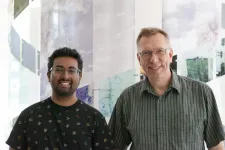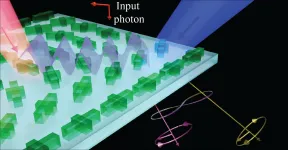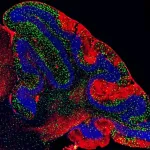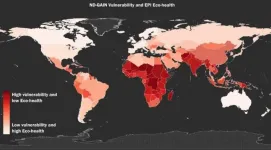How does the structure of cytolysins influence their activity?
2021-07-21
(Press-News.org) Although Enterococcus faecalis is usually an innocuous member of the bacterial community in the human gut, it can also cause several infections, including liver disorders. The bacteria produce cytolysins, which are molecules that destroy cells. In a new study, researchers have uncovered how they do so.
"Your chances of dying increase by 5-fold when you get infected by E. faecalis that can make cytolysin compared to those that cannot," said Wilfred van der Donk (MMG), a professor of chemistry and investigator of the Howard Hughes Medical Institute. "Cytolysin is an important molecule and it has been known since the 1930s, our lab determined the cytolysin structure only in 2013."
Concerningly, E. faecalis is resistant to vancomycin, which is used as a last resort to treat bacterial infections. By understanding how cytolysins affect cells, the researchers hope to prevent its production and reduce the number of lethal infections.
Cytolysin is made up of two subunits, CylLL" and CylLS", which have been previously shown to kill both mammalian and bacterial cells. The structure of the subunits is stabilized with the help of rings, called macrocycles, that staple the ends and prevent the structure from unfolding. To understand how they work, the researchers replaced each amino acid in both these subunits to determine which amino acids are important.
"After mutating the amino acid residues, we purified and tested each of the mutants to see whether they had anti-bacterial activity or if they could lyse rabbit blood cells," said Imran Rahman, a graduate student in the van der Donk lab and the first author of the paper. "We found that the macrocyclizations in both subunits are important for both activities."
Additionally, the researchers discovered that CylLL" contains a hinge region which is also important. "The hinge contains three consecutive glycine residues and if we delete them, CylLL" becomes so unstable that we can no longer purify it," Rahman said.
The residues help CylLL" switch between two different shapes: a jackknife and an elongated form that can span across the bacterial membrane. "When it's longer, the subunit can make holes in the membrane and we think that's why the glycine residues are required for its activity," van der Donk said.
The researchers are interested in identifying the targets of cytolysin. "These molecules are unusual because unlike our current antibiotics, which bind to big cellular targets, these bind to small molecules and seem to use them to make holes in the membrane," van der Donk said. "We don't know what their targets are and we're working to find them."
INFORMATION:
The study "Structure-Activity Relationships of the Enterococcal Cytolysin" was published in ACS Infectious Diseases and can be found at https://doi.org/10.1021/acsinfecdis.1c00197. The work was funded by the Howard Hughes Medical Institute and the NIGMS-NIH Chemistry-Biology Interface Training Grant.
[Attachments] See images for this press release:

ELSE PRESS RELEASES FROM THIS DATE:
2021-07-21
Researchers from the University of Southern California (USC) Department of Computer Science and NVIDIA have unveiled a new simulator for robotic cutting that can accurately reproduce the forces acting on a knife as it slices through common foodstuffs, such as fruit and vegetables. The system could also simulate cutting through human tissue, offering potential applications in surgical robotics. The paper was presented at the Robotics: Science and Systems (RSS) Conference 2021 on July 16, where it received the Best Student Paper Award.
In the past, researchers have had trouble creating intelligent ...
2021-07-21
Los Alamos, N.M., July 21, 2021--A team of scientists at Los Alamos National Laboratory propose that modulated quantum metasurfaces can control all properties of photonic qubits, a breakthrough that could impact the fields of quantum information, communications, sensing and imaging, as well as energy and momentum harvesting. The results of their study were released yesterday in the journal Physical Review Letters, published by the American Physical Society.
"People have studied classical metasurfaces for a long time," says Diego Dalvit, who works in the Condensed Matter and Complex Systems group at the Laboratory's Theoretical Division. "But we came up with this new idea, which was to modulate in time and space the optical properties of ...
2021-07-21
Northwestern University researchers have developed a new framework using machine learning that improves the accuracy of interatomic potentials -- the guiding rules describing how atoms interact -- in new materials design. The findings could lead to more accurate predictions of how new materials transfer heat, deform, and fail at the atomic scale.
Designing new nanomaterials is an important aspect of developing next-generation devices used in electronics, sensors, energy harvesting and storage, optical detectors, and structural materials. To design these materials, researchers create interatomic potentials through atomistic modeling, a computational approach that predicts how these materials behave by accounting for their ...
2021-07-21
In a recently published paper, a research team, led by University of Miami (UM) Rosenstiel School of Marine and Atmospheric Science Professor Emeritus Joseph M. Prospero, chronicles the history of African dust transport, including three independent "first" discoveries of African dust in the Caribbean Basin in the 1950s and 1960s.
Every year, mineral-rich dust from North Africa's Sahara Desert is lifted into the atmosphere by winds and carried on a 5,000-mile journey across the North Atlantic to the Americas. African dust contains iron, phosphorus and other important nutrients that are essential for life in marine and terrestrial ...
2021-07-21
BROOKLYN, New York, Weekday, Month xx, 2021 - The remarkable structural properties of the Venus' flower basket sponge (E. aspergillum) might seem fathoms removed from human-engineered structures. However, insights into how the organism's latticework of holes and ridges influences the hydrodynamics of seawater in its vicinity could lead to advanced designs for buildings, bridges, marine vehicles and aircraft, and anything that must respond safely to forces imposed by the flow of air or water.
While past research has investigated the structure of the sponge, there have been few studies of the hydrodynamic fields surrounding and penetrating the organism, and whether, besides improving its mechanical ...
2021-07-21
BROOKLYN, New York, Wednesday, July 21, 2021 - This week, at the 38th International Conference on Machine Learning (ICML 21), researchers at the END ...
2021-07-21
Efforts to understand cardiac disease progression and develop therapeutic tissues that can repair the human heart are just a few areas of focus for the Feinberg research group at Carnegie Mellon University. The group's latest dynamic model, created in partnership with collaborators in the Netherlands, mimics physiologic loads on engineering heart muscle tissues, yielding an unprecedented view of how genetics and mechanical forces contribute to heart muscle function.
"Our lab has been working for a long time on engineering and building human heart muscle tissue, so we can better ...
2021-07-21
UT Southwestern researchers have identified an immune protein tied to the rare neurodegenerative condition known as Niemann-Pick disease type C. The END ...
2021-07-21
For more than 30 years, scientists on the U.N.'s Intergovernmental Panel on Climate Change have focused on human-induced climate change. Their fifth assessment report led to the Paris Agreement in 2015 and, shortly after, a special report on the danger of global warming exceeding 1.5 degrees Celsius above pre-industrial levels. The Nobel Prize-winning team stressed that mitigating global warming "would make it markedly easier to achieve many aspects of sustainable development, with greater potential to eradicate poverty and reduce inequalities."
In a first-of-its-kind study that combines assessments of the risks of toxic emissions (e.g., fine particulate matter), ...
2021-07-21
COLUMBUS, Ohio - Exoskeletons - wearable devices used by workers on assembly lines or in warehouses to alleviate stress on their lower backs - may compete with valuable resources in the brain while people work, canceling out the physical benefits of wearing them, a new study suggests.
The study, published recently in the journal Applied Ergonomics, found that when people wore exoskeletons while performing tasks that required them to think about their actions, their brains worked overtime and their bodies competed with the exoskeletons rather than working in harmony with them. The study indicates that exoskeletons may place enough burden on the brain that potential benefits to the body are negated.
"It's almost like dancing with a really bad partner," said ...
LAST 30 PRESS RELEASES:
[Press-News.org] How does the structure of cytolysins influence their activity?




